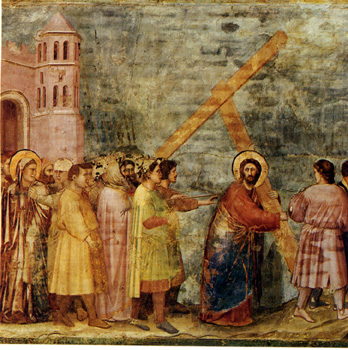Washing the Feet of the Disciples
 To help the disciples
understand humility Christ washes their feet. This is still done
by the Pope to his cardinals during the week prior to Easter.
To help the disciples
understand humility Christ washes their feet. This is still done
by the Pope to his cardinals during the week prior to Easter.
This scene is almost like a still-life it
is so quiet and dramatic.
 This is a classic
example of the confrontation between good and evil. Look at the
bestial features of Judas and the noble features of Christ. All
the spears seem to point at the focal point in the center. On
the left is Peter, with a halo, about to cut off the ear of Malchus,
the high priest's servant. On the right the high priest is shown
with his finger contracting as is the cloak of Judas. This scene
is embedded with high drama.
This is a classic
example of the confrontation between good and evil. Look at the
bestial features of Judas and the noble features of Christ. All
the spears seem to point at the focal point in the center. On
the left is Peter, with a halo, about to cut off the ear of Malchus,
the high priest's servant. On the right the high priest is shown
with his finger contracting as is the cloak of Judas. This scene
is embedded with high drama. Look at the realism
of the wooden cages and stalls. The cage held by one of the money-changers
was an afterthought, added when the plaster was almost dry, and
for this reason it is barely visible today.
Look at the realism
of the wooden cages and stalls. The cage held by one of the money-changers
was an afterthought, added when the plaster was almost dry, and
for this reason it is barely visible today. After his capture
Christ is brought before Caiaphas the high priest. This appears
to be a night scene in which the wooden ceiling room has been
illuminated from below by a torch. Giotto doesn't allow the violence
and drama of this scene to interfere with the figure of Christ
which is isolated and turned in upon itself.
After his capture
Christ is brought before Caiaphas the high priest. This appears
to be a night scene in which the wooden ceiling room has been
illuminated from below by a torch. Giotto doesn't allow the violence
and drama of this scene to interfere with the figure of Christ
which is isolated and turned in upon itself. In this scene we
see the scourging of Christ, or beating, often referred to as
the flagellation. Christ is given the crown of thorns mockingly
to be called the King of the Jews. The black figure in the center,
by his diagonal movement, focuses us on the figure of Christ
on the left.
In this scene we
see the scourging of Christ, or beating, often referred to as
the flagellation. Christ is given the crown of thorns mockingly
to be called the King of the Jews. The black figure in the center,
by his diagonal movement, focuses us on the figure of Christ
on the left. Christ
is now forced to carry the cross on the Road to Calvary. The
movement goes from left to right with a figure aptly placed on
the right to force our attention back to Christ.
Christ
is now forced to carry the cross on the Road to Calvary. The
movement goes from left to right with a figure aptly placed on
the right to force our attention back to Christ.  This is the first
modern interpretation of the Crucifixion. Instead of the Byzantine
unrealistic presentation we see a real body with solid weight
hanging from the Cross. There are two blocks of figures on either
side that accent the tragedy. On the left is the Madonna and
at the foot of Christ is Mary Magdalene with her long flowing
hair. On the right are the soldiers gambling for the robe of
Christ. Above in the sky are grieving angels flying in desperation.
This is the first
modern interpretation of the Crucifixion. Instead of the Byzantine
unrealistic presentation we see a real body with solid weight
hanging from the Cross. There are two blocks of figures on either
side that accent the tragedy. On the left is the Madonna and
at the foot of Christ is Mary Magdalene with her long flowing
hair. On the right are the soldiers gambling for the robe of
Christ. Above in the sky are grieving angels flying in desperation. After the Crucifixion
and after Christ was taken from the cross, known as the Deposition,
a scene that follows is that of the Lamentation or the mourning
of Christ.
After the Crucifixion
and after Christ was taken from the cross, known as the Deposition,
a scene that follows is that of the Lamentation or the mourning
of Christ. 
 Giotto actually
portrays two scenes here: the angel at the tomb and the sleeping
soldiers, and the Resurrection. After the Resurrection Christ
appears triumphantly, with the flag, to Mary Magdalene and he
says to her "Noli me tangere" meaning "Don't touch
me" until I have seen my father.
Giotto actually
portrays two scenes here: the angel at the tomb and the sleeping
soldiers, and the Resurrection. After the Resurrection Christ
appears triumphantly, with the flag, to Mary Magdalene and he
says to her "Noli me tangere" meaning "Don't touch
me" until I have seen my father. After the resurrection
this scene shows the ascension of Christ to heaven.
After the resurrection
this scene shows the ascension of Christ to heaven.